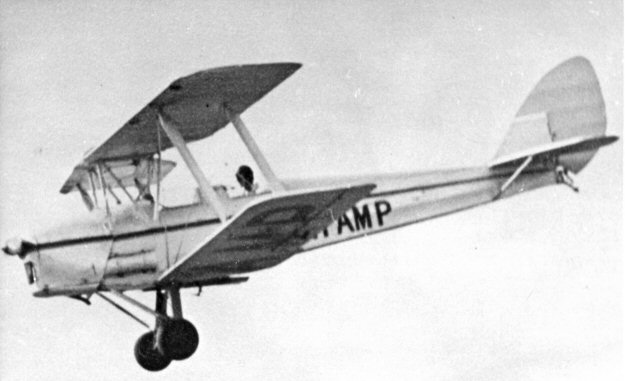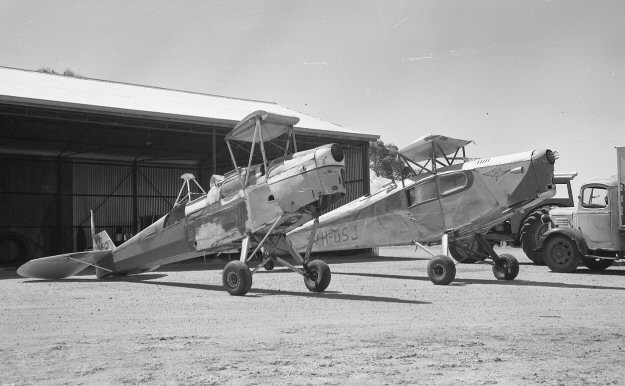VH-AMP
("VH-WLQ") de Havilland D.H.82A Tiger
Moth (c/n DHA358)

The above Ted Fletcher photo (via the Geoff Goodall
collection) shows VH-AMP circa 1948 while
the Tiger was
with the Aero Club of WA (The club did not receive its "Royal"
status until 1951). In
1953 this was among the
first Tigers in WA to be converted for aerial agriculture, and was
operated
by Bob Couper Co at
Cunderdin. Immediately below is an image by Geoff taken on
a
farm near
Cunderdin, WA in January
1969 after it
had been fitted with the fin and rudder of VH-WFQ.
The
Fox Moth
VH-USJ was also rolled out for Geoff's
photo-op. (Nice of them). -AMP was one of a
large fleet
of cropdusting Tiger Moths operated by Bob
Couper Co, based at the old WW2 No.9
EFTS aerodrome at
Cunderdin. When the type was
grounded for agricultural service by DCA in
1965, Bob Couper Co
was
left with a large collection of
dismantled agricultural Tigers, crashed
aircraft and spare
fuselages
and wings. At that time Tiger Moth
components had little value, and this
whole collection, along
with the Fox
Moth were acquired "as is" by a
local farmer and moved to a
shed on his farm near the
aerodrome.
A few years later the collection, which
included a dozen Tiger
Moth fuselages, was
sold to Les Kordys at
Trayning, WA and moved to a storage
shed in the main
street of this small
wheatbelt town. Happily,
some years later the collection
of Tigers was purchased
by a restoration
operation at Luskintyre, NSW
where a "production line" of newly
restored Tigers
was set up. Photos of
many of these appear on
this website However, VH-AMP did not wind up
on the Luskintyre
production line. In January 1974. this Tiger, the former A17-339
and
originally
civilianized early in
1946, was given a minimal restoration
for display in a folk museum in
Cunderdin.
It was meant to commemorate the many
RAAF Tiger
Moths which had trained pilots at the local
EFTS during the war, and
was painted up in RAAF trainer yellow.
Unfortunately the locals who did
the
job left part of the agricultural spraying gear under the fuselage and,
for reasons unknown, decided
it
should have a civil registration painted on, rather than its real
RAAF serial (A17-339). Since it had
been fitted with the fin
of one of Bob Couper's other Tigers (VH-WFQ),
they chose this for a civil
registration.
However, to compound the felony, even this fact got
lost in the translation and the poor
old thing was
was painted as "VH-WLQ", a registration which was never used on a Tiger
Moth.
The
identity of this displayed aircraft has caused consternation to plane
spotting enthusiasts ever since!
Geoff's
shot at the foot of the page was in January 1974, just after it had
been
suspended from the ceiling.



